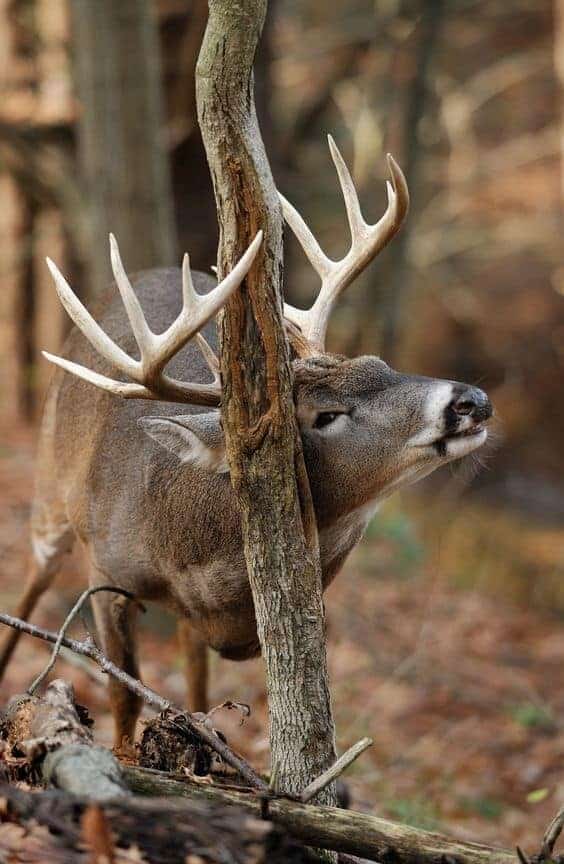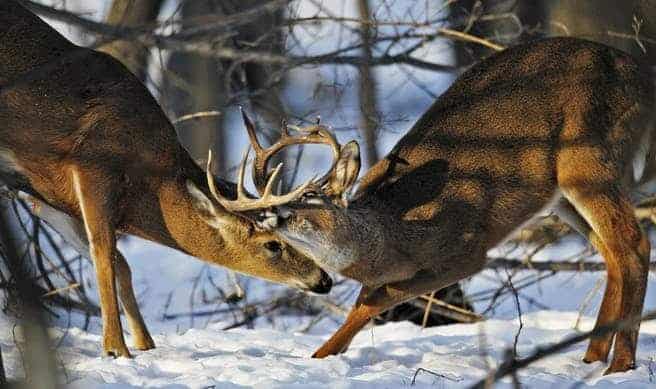Most of the myths and misconceptions you carry around today about whitetail deer are probably from your childhood. It was easier to believe those fireplace stories about deer from your dad or granddad without a reason to question or doubt them. However, as you grow up and learn some things yourself, you get to demystify and debunk some of these myths the hard way. You get to understand what is true and what’s not, constantly evolving and becoming a better hunter.
The whitetail deer’s myths revolve around their behavior around mates, their life cycle, their fears, and power, among other subjects. Today we will help you understand which of the myths you have believed are only just myths and those that are facts proven and backed up by research.
1| Whitetail Deer Are Color Blind
You have probably heard the stories of whitetails’ problems with color differentiation. Earlier on, people believed whitetails were color blind and saw everything in black and white shades. However, according to research, the color-blindness myth remains to be just a myth or maybe a half-truth.
RELATED ARTICLE: CAN WHITETAIL SEE ORANGE?
Research proves that whitetails only have problems with detecting red or green colors. Their eyes are meant to pick out yellow, violet, and blue colors, which proves they are not color blind.
Whitetails’ eyes can easily pick lighter versions of the orange color, but the darker version falls into the red spectrum, and they would detect it as a brownish color. They can pick up light that is reflecting off hard surfaces. When colors come from shaded darker backgrounds, whitetails will have problems detecting them.
2| Bucks Only Concentrate on Scrapes During the Rut
While bucks majorly paw scrapes during the rutting period, it is not necessarily true that they paw the scrapes only during that period. There are high chances you will find ‘fresh’ scrapes all year round, not necessarily during the rutting period. This is because bucks feel the need to communicate their presence to each other regardless of the year’s time.
RELATED POST: WHICH IS BETTER TO HUNT SCRAPES OR RUBS?
The scraping activity hits its peak two weeks towards the breeding period. During this time, the scraping involves new techniques, including the buck urinating over their tarsal glands into the scrape to mark territories.
3| Big Bucks only Rub Against Big Trees
This is not true. Bigger bucks will set out to rub all sizes of trees. The size of the tree does not really matter. Many times will make a “rub line” where they rub multiple trees in an area. They can not do this if they only rub small trees. So large bucks will rub anything, and it is the same story for little bucks as well.
RELATED POST: WHY DO BUCKS RUB TREES?

4| Whitetails Never Migrate
The average whitetail spends its entire life inside a square mile. Although when conditions are harsh they need to move on and find reliable food sources. When you consider the distance most whitetails travel when searching for food, this myth might be true if they only cover about 3 miles. However, some of the time, whitetail movements extend to up to 50 miles or more when they’re searching for resources to sustain them. These long-distance movements always translate to migration and always occur during winter when conditions are extreme.
So, whitetails do migrate, and several factors influence their migrations. These factors include food, warmth, nutrition, depth of the snow, and extensive cold seasons. While the females and young ones tend to migrate first, the bucks lag where they rutted. The migration journey generally takes 24-31 days on average.
5| The Biggest Buck Wins the Girls
It is not a myth anymore as this happens a lot, and it’s a sorry state of affairs to the smaller bucks in the herd. The bigger bucks get to choose the females they want thanks to their intimidating physique. The whole process is even easier for the buck if it is there at the right time, and the doe is willing to get tagged along.
When a smaller buck comes into the picture, the bigger one doesn’t need to fight him off. He intimidates the smaller one with his huge and powerful physique. The only hope for the younger and smaller buck is to sneak in and breed with the stronger buck’s females in his absence.
Bigger bucks don’t always guarantee offspring with the mates they find. On the contrary, some research on Bucks and their Progenies proves that the buck’s size is not directly proportional to the success rate of offspring reproduction and survival.

6| Warm Temperature Reduces the Amount of Daytime Rutting
This may not be a myth anymore. After all, warm temperatures do impact the amount of daytime rutting activity exhibited by the bucks. If you are hunting whitetail deer, you may, at times, be pushed back by a sudden decrease in their chasing and breeding activities during legal shooting hours. This normally happens when temperatures rise a little but do not mean the rut has stopped.
Most of the rutting activities shift to the night as things cool down, making it somehow true that warm temperatures reduce daytime rutting. As a hunter, when you notice rutting activities reducing during the day due to unseasonably warm weather, you should advance your moves. Set up near to the doe bedding areas as you focus on early mornings and late evening hunts.
7| Bigger Parcels of Land Hide and Host Bigger Bucks
This myth brings with it two points of view, which are all true and factual based on past behaviors of the bucks. The first point of view agrees with the myth that large parcels of land harbor bigger bucks. It is highly likely to find large tracts of land with a consistent supply of whitetail deer foods, many thickets, and plenty of hideouts. All these summarize the ideal environment for the bigger bucks.
The small parcels of land, on the other hand, are also ideal hideouts for the bigger bucks since hunters overlook such places. You should not be amazed to find a monster buck settling in one of these small parcels where they can get food, mates, and isolate themselves from competition and risk of death.

8| Older Bucks Can Move Into the Wind Anytime They Wish
Older bucks moving into the wind anytime they wish remains only that, a myth. If this myth was true, we could be having a surge of old bucks in the far northwestern whitetail country or any other direction the predominant winds would be heading to.
However, the fact is that whitetail deer use the wind in their favor to search for food and run away from predators. When on the run, they use their eye to detect motion ahead, both on their side and backward. Whitetails usually have the wind at their back and trust that their eyes will keep them alerted of any danger coming from the front.
9| Whitetails Rush to the Hills When Shooting Begins
A whitetail deer’s core area is so essential to it that it always strays a few miles when scared off and comes back when it is safe. When scared, a deer’s instincts and fears don’t allow it to seek homage in new places. It is, therefore, unlikely for them to run for the hills for safety when shooting begins.
In most of the findings of bucks’ movements, it has been found that as bucks get older, they tend to get more satisfied with their homes and are less likely to leave. Since they have survived most of their life in such places, it becomes unreasonable to flee to an unknown location for safety.
10| The Largest Bucks Are Found Far off the Roads
This myth could have been true if we were still in the 19th and 20th centuries. When urban development encroached the whitetail deer hideouts at the onset of the 21st century, things had to change. Roads are now spread almost everywhere, and while traveling to the most remote of places, you are likely to spot a whitetail deer grazing along the road.
Conclusion
Studying whitetail deer will give you a better insight into how they behave and react to changes around them. This may help you demystify or debunk most of the myths you may have about them first hand. You can now start writing off the half-truths you have believed since you were young and embrace the realities and facts as research proves them.
Thank you for reading my article about whitetail myths. I hope you enjoyed it and learned something you didn’t already know. If you like my content, subscribe to my weekly update. If you have any other questions about these whitetail myths or just want to connect, feel free to email me at Patrick.Long@omegaoutdoors.net.
